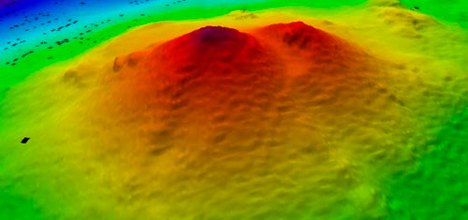Scientists are saying the Tangaroa seamount off the Bay of Plenty coast should be declared off limits to commercial exploitation by fishing and mining.
A group of Wellington scientists have just confirmed volcanic activity on the deep water seamount.
A sonar image of the Tangaroa Seamount. Image: Niwa.
Niwa principal scientist Malcolm Clark says they have discovered new hydrothermal vents, which create chimney-like structures.
'Some of the venting we found was very high temperature, black smoker type situations, where the temperature is several hundred degrees Celsius,” says Malcolm.
He has just returned from taking the first biological samples of the animals which have adapted to Tangaroa's unique environmental conditions.
The top of the seamount is nearly a kilometre below the ocean's surface.
'These are species which are adapted to live in quite extreme conditions, high levels of hydrogen sulphide which is toxic to most life forms, quite high temperatures, they're deep, there's no light, they're under quite high pressure,” says Malcolm.
The research will help agencies protect these habitats from fishing or mining.
'These seamounts and deep sea areas in general are sites of deep sea trawling for species like orange roughy and they're also of interest for seabed mining,” says Malcolm.
While there's no sea bed mining at the moment, Australian-based companies Nautilus and Neptune minerals have licences to explore for what is known as "sea floor massive sulphides”.
'These are deposits that are rich in copper and zinc and also some gold and silver associated with them that occur on the seamounts,” says Malcolm.
Niwa's research vessel Tangaroa recently returned from a three-week voyage, with pictures, film footage and samples of new discoveries from the deep-sea floor, including footage of a new hydrothermal vent on an undersea volcano on the Tangaroa seamount.
"We were able to collect both underwater footage and specimens of chemosynthetic barnacles, mussels, and shrimps on Tangaroa Seamount,” says Malcolm.
There are 50 submarine volcanoes stretching along the Kermadec Ridge. It's a significant feature of the Western Pacific, extending almost 1500km to the edge of the New Zealand., northeast of the Kermadec Islands.
Hydrothermal vents associated with these volcanoes release hot water and gases with different chemical compositions, so specific communities have adapted to survive in each area.
"The benthic community on Tangaroa seamount, a combination of mussels and barnacles and shrimps, isn't unique, but differs from that found on a number of neighbouring seamounts. 'The seamount communities were also very different from those we observed and sampled on the slope and canyons, which typically had muddy seafloor, rather than rocks.
"This trip confirmed our working hypothesis that the environments generated in these different deep-sea habitats vary in their characteristics, and they result in faunal communities that can differ, within close proximity," says Malcolm.
"The implication is that the exploitation of one seamount could have an effect that is not the same as the seamount close by.”



2 comments
Why not lock everything up!
Posted on 04-06-2012 10:47 | By TheCameltoeKid
Let's have a total ban on all mining, gas and oil drilling ok. Then let's clean up the dairy industry to the point where it will be totally uneconomic to be a farmer. Now the whole human race is to exist on vegetables, friut and water. This would be the ideal in a green world. How long would it take for total anarchy to take hold. People like Malcom Clark are no-doubt genuine in their research however I feel that his focus would be better spent on trying to develop more economic and sustainable food sources.
last frontiers deserve better
Posted on 15-06-2012 02:21 | By IanM
I think almost all of us would agree with theCameltoeKid that sustainable exploitation of our food sources would be a good thing. Unfortunately, deep water fisheries are one of the least sustainable industries we have - the destruction of orange roughy populations being a prime example. We are now desperately trying to conserve remnant populations of all sorts of things on land. Let's consider protection before destruction in this case.
Leave a Comment
You must be logged in to make a comment.